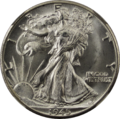  | |
| Walking Liberty half dollar |
Below are the mintage figures for the United States half dollar up to 1963, before the Kennedy half dollar design was introduced. For those, see:
Contents
- Flowing Hair half dollar
- Draped Bust half dollars
- Small eagle reverse
- Heraldic eagle reverse
- Capped Bust half dollar
- Lettered Edge
- Reeded Edge
- Seated Liberty half dollar
- No motto
- Arrows and rays, no motto
- Arrows, no rays or motto
- No motto, arrows, or rays
- Motto, no arrows
- Motto and arrows
- Motto, no arrows 2
- Barber half dollar
- Walking Liberty half dollar
- Type 1
- Type 2
- Franklin half dollars
- Kennedy half dollar mintages
- See also
- References
The following mint marks indicate which mint the coin was made at (parentheses indicate a lack of a mint mark):
D = Denver Mint
W = West Point Mint
O = New Orleans Mint
CC = Carson City Mint